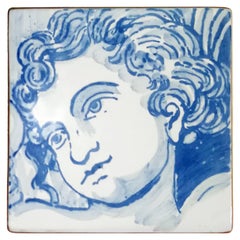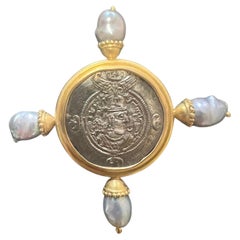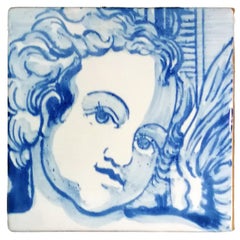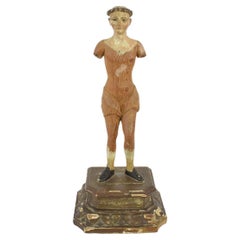Collectibles and Curiosities
Late 19th Century French Empire Antique Collectibles and Curiosities
Bronze
Late 20th Century Portuguese Baroque Collectibles and Curiosities
Delft, Faience, Terracotta
20th Century Baroque Collectibles and Curiosities
Gold
Late 20th Century Portuguese Baroque Collectibles and Curiosities
Delft, Faience, Terracotta
19th Century Italian Baroque Antique Collectibles and Curiosities
Wood
1670s European Baroque Antique Collectibles and Curiosities
Paper
17th Century Spanish Baroque Antique Collectibles and Curiosities
Bronze, Other
19th Century Italian Baroque Antique Collectibles and Curiosities
Pine
1670s English Baroque Antique Collectibles and Curiosities
Paper
18th Century Italian Baroque Antique Collectibles and Curiosities
Bronze
17th Century European Baroque Antique Collectibles and Curiosities
Metal, Silver, Other
Early 1900s Spanish Baroque Antique Collectibles and Curiosities
Wrought Iron
Mid-17th Century European Baroque Antique Collectibles and Curiosities
Wood, Giltwood
Mid-17th Century Italian Baroque Antique Collectibles and Curiosities
Copper
17th Century English Baroque Antique Collectibles and Curiosities
Paper
17th Century Portuguese Baroque Antique Collectibles and Curiosities
Porcelain
18th Century Philippine Baroque Antique Collectibles and Curiosities
Hardwood
1680s Albanian Baroque Antique Collectibles and Curiosities
Gold Leaf, Silver Leaf
Late 17th Century Spanish Baroque Antique Collectibles and Curiosities
Copper, Other
17th Century English Baroque Antique Collectibles and Curiosities
Paper
Mid-18th Century Dutch Baroque Antique Collectibles and Curiosities
Brass
18th Century Spanish Baroque Antique Collectibles and Curiosities
Silver
17th Century European Baroque Antique Collectibles and Curiosities
Wrought Iron
18th Century Italian Baroque Antique Collectibles and Curiosities
Copper
17th Century Spanish Baroque Antique Collectibles and Curiosities
Metal, Other
Late 19th Century French Empire Antique Collectibles and Curiosities
Wood
19th Century Italian Baroque Antique Collectibles and Curiosities
Metal
19th Century Italian Baroque Antique Collectibles and Curiosities
Gold, Silver
17th Century British Baroque Antique Collectibles and Curiosities
Paper
17th Century Portuguese Baroque Antique Collectibles and Curiosities
Porcelain
1760s German Baroque Antique Collectibles and Curiosities
Wood
Early 17th Century Spanish Baroque Antique Collectibles and Curiosities
Walnut
Early 19th Century French Empire Antique Collectibles and Curiosities
Crystal, Silver
18th Century Spanish Baroque Antique Collectibles and Curiosities
Iron
1730s Austrian Baroque Antique Collectibles and Curiosities
Brass
Mid-20th Century Italian Baroque Collectibles and Curiosities
Wood
18th Century German Baroque Antique Collectibles and Curiosities
Blown Glass
17th Century Italian Baroque Antique Collectibles and Curiosities
Copper
Late 20th Century Portuguese Baroque Collectibles and Curiosities
Delft, Faience, Terracotta
17th Century European Baroque Antique Collectibles and Curiosities
Other
Mid-19th Century Italian Baroque Antique Collectibles and Curiosities
Bronze
1760s German Baroque Antique Collectibles and Curiosities
Wood
Early 19th Century French Empire Antique Collectibles and Curiosities
Mahogany
Late 18th Century Spanish Baroque Antique Collectibles and Curiosities
Silver
17th Century European Baroque Antique Collectibles and Curiosities
Textile
Late 20th Century French Baroque Collectibles and Curiosities
Linen, Silk
18th Century Central American Baroque Antique Collectibles and Curiosities
Wood, Pine, Paint
Mid-17th Century Italian Baroque Antique Collectibles and Curiosities
Wood, Canvas
Late 18th Century Italian Baroque Antique Collectibles and Curiosities
Metal
Mid-18th Century German Baroque Antique Collectibles and Curiosities
Silver
17th Century Spanish Baroque Antique Collectibles and Curiosities
Wood
Late 19th Century French Baroque Antique Collectibles and Curiosities
Walnut, Nutwood
1970s Italian Baroque Vintage Collectibles and Curiosities
Paper
Late 19th Century French Empire Antique Collectibles and Curiosities
Bronze
Early 19th Century French Empire Antique Collectibles and Curiosities
Walnut
1750s Italian Baroque Antique Collectibles and Curiosities
Walnut
Early 20th Century German Empire Collectibles and Curiosities
Mahogany
Late 20th Century Portuguese Baroque Collectibles and Curiosities
Delft, Faience, Terracotta
Antique and Vintage Collectibles and Curiosities for Sale
Antique and vintage collectibles and curiosities can bring whimsy and wonder to any interior.
Decorating with old scientific instruments, historical memorabilia and vintage musical instruments, as well as other authentic collectibles and curiosities that can be found on 1stDibs, presents an opportunity to create a unique, natural history museum-like atmosphere in your home that can provoke conversation as often as it pays tribute to how far we’ve come in understanding our world.
And bringing collectibles and curiosities into your space is actually on trend — Wunderkammern, or curiosity cabinets, were all the rage in Europe during the 1500s and continued to have adherents there and in the U.S. in the following centuries. Today, however, they’re experiencing a real surge in popularity and influencing how many interior designers are furnishing and decorating homes — combining contemporary with antique, scientific with tribal, earthly with extraterrestrial, Les Lalanne tables with Flemish tapestries.
The original Wunderkammern were entire rooms filled with objects demonstrating their owners’ worldly knowledge: A proper one included artificiala or preciosa (objets d’art); naturalia (such as skeletons, shells, minerals); exotica (taxidermy or dried plants); and scientifica (scientific instruments), frequently alongside religious relics and ancient artifacts.
Pay tribute to a history of rich and diverse musical traditions that have taken shape all over the world by decorating your home with a collection of antique and vintage musical instruments — with a little help from strong hanging wire or some wall hooks, vintage brass instruments such as a gong, French horn or trumpet can help elevate a home office or complement the efforts you’ve made to ensure a welcoming vibe in your home’s entryway. Bells or antique wind instruments can add provocative metallic contrasts to dark woods as tabletop decorative objects.
Create an intriguing focal point with Georgian scientific instruments, such as stick barometers with mahogany cases or lacquered brass telescopes. These items stem from an era named for the monarchies of the four King Georges, who ruled England in succession starting in 1714 (plus King William’s reign, which lasted until 1837). Just as there was beautiful jewelry produced during the period that today is coveted by collectors, there is much to be found in the collectibles and curiosities realm too.
Wanderlust, nostalgia and a shared love of good design are contributing factors to certain trends in decorating — just as vintage trunks and luggage have reappeared as furniture or home accents in a bedroom or foyer, decorating with globes, maps or nautical objects is similarly rooted in the allure of travel and a penchant for the stylish finishing touch that collectibles bring to our homes.
Find a wide range of antique and vintage collectibles and curiosities on 1stDibs.





